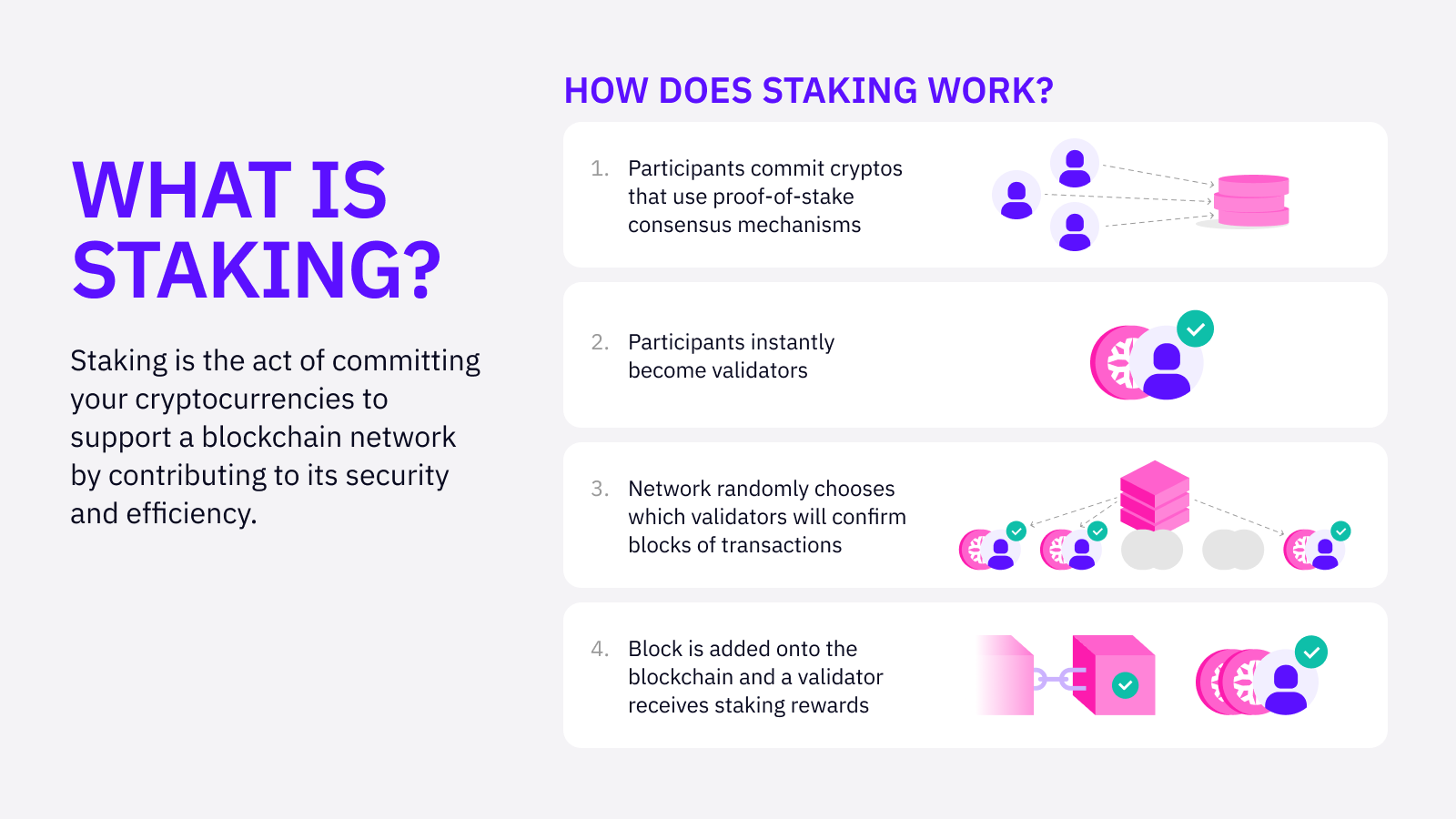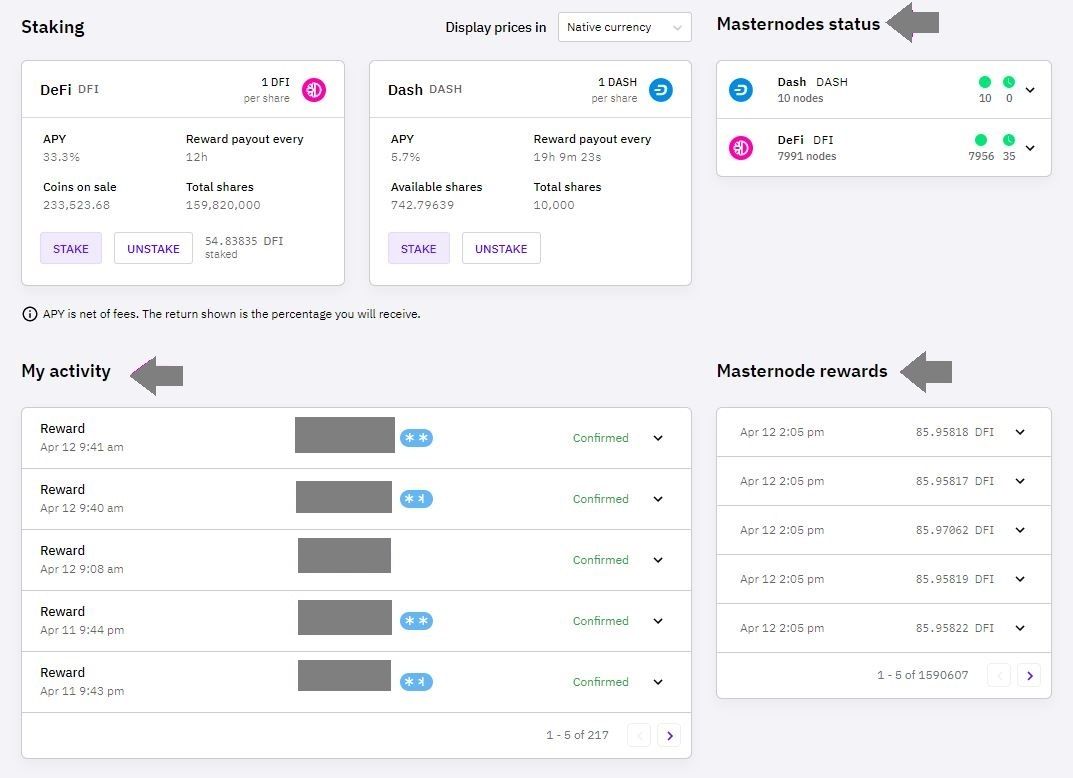What Is Staking?
If you have just started learning about how to make money with your cryptocurrencies or are looking at new ways to level up your crypto investment portfolio, you’ve probably come across the term “crypto staking” or “staking.”
What is it, how does it work and why is it popular among crypto investors? This article provides answers to these questions and more. So, read on!
KEY TAKEAWAYS
- Definition of Staking
- How Does Staking Work?
- How Do I Participate In Staking?
- What Are the Advantages & Disadvantages of Staking?

Definition of Staking
True to its literal meaning, staking is the act of committing your cryptocurrencies to support a blockchain network by contributing to its security and efficiency. How does staking do that? By staking their cryptos, participants help strengthen the blockchain’s ability to process and verify transactions, thus, allowing it to run smoothly and become resistant to malicious attacks.
In return, participants receive staking rewards - which is why it has become a popular source of passive income and means of generating cash flow among serious crypto investors.
How Does Staking Work?
In order to really understand how staking works, one must first be familiar with proof-of-stake. What is it? It’s a type of consensus mechanism used to validate cryptocurrency transactions. Under this system, participants can stake their cryptos for a chance of getting to validate new transactions, update the blockchain and earn a reward.
With that, it should be noted that you can only stake cryptos that use proof-of-stake consensus mechanisms such as DASH and DFI - the native cryptocurrency of the DeFiChain blockchain.
How does it actually work?
Upon committing their cryptocurrencies, staking participants instantly become validators for the network to randomly choose from to confirm blocks of transactions. That said, it is a well-known fact that the larger amount of cryptos that you commit, the higher chance you get for being chosen as the next block validator.
Each time a block is added onto the blockchain, new cryptocurrencies are minted and distributed as staking rewards to that block's validator. In most cases, the staking reward received is the blockchain’s native cryptocurrency.


How Do I Participate In Staking?
Given that you already own cryptocurrencies that use proof-of-stake consensus mechanisms and that you have already thought about things such as the amount of cryptos you’d like to commit, then you may participate in staking through crypto exchanges or wallets that provide such service or option.
You may also choose to become a full validator by setting up your own node and running it yourself. This approach, however, not only requires you to have a fair amount of knowledge and expertise in staking, but also meet the staking minimum as required by the blockchain - which is, normally, a substantial amount of cryptos.
Finally, you may opt for platforms that offer easy-to-use staking services such as Cake DeFi. By using our staking service, participants receive administrative support and can potentially benefit from high returns with its highly-competitive APYs. They are not required to have technical expertise or commit a huge amount of cryptocurrencies.
Moverover, we provide full transparency with our masternodes and masternode rewards. Each participant can easily track their staking activities as well.

What Are the Advantages & Disadvantages of Staking?
All things considered, staking provides a better option for investors to put their cryptos to work and generate returns as opposed to just HODLing. It doesn’t really require technical expertise on cryptocurrencies or hefty investment on equipment, especially if you opt for using platforms such as Cake DeFi.
Depending on what cryptocurrencies they own and how much they stake, participants can also gain huge returns - and they can do so in a passive and environment-friendly way.
That said, participants will have to wait for those potentially huge as staking often requires a lockup or vesting period. This means that you’ll most likely not be able to access the cryptos that you’ve committed for a certain period of time. These cryptocurrencies are also still prone to the market’s volatility, and that their prices may change - even during the lockup period.
So, is staking worth trying?
The answer to that question may very well depend on your risk tolerance. Also, you should be able to figure out what kind of crypto investor you consider yourself to be: are you in it for the short term or long term? If you consider yourself to be the latter, then perhaps you should give staking a try.
If you want to know more about staking or other ways of making money with your cryptocurrencies, you may read this article or check out our blog section for more information on the subject.
If you want to use our staking service but are not yet a registered Cake DeFi user, you may click here to sign up and start generating passive income with us. You will get US$30 worth of DFI tokens when you register successfully and make a deposit of US$50 or more, and allocate the amount for at least 28 days into either our Lending, Staking Freezer or Liquidity Mining Freezer service.
And that’s it! Thanks for reading this article. We look forward to seeing you “bake” your first crypto rewards very soon!





